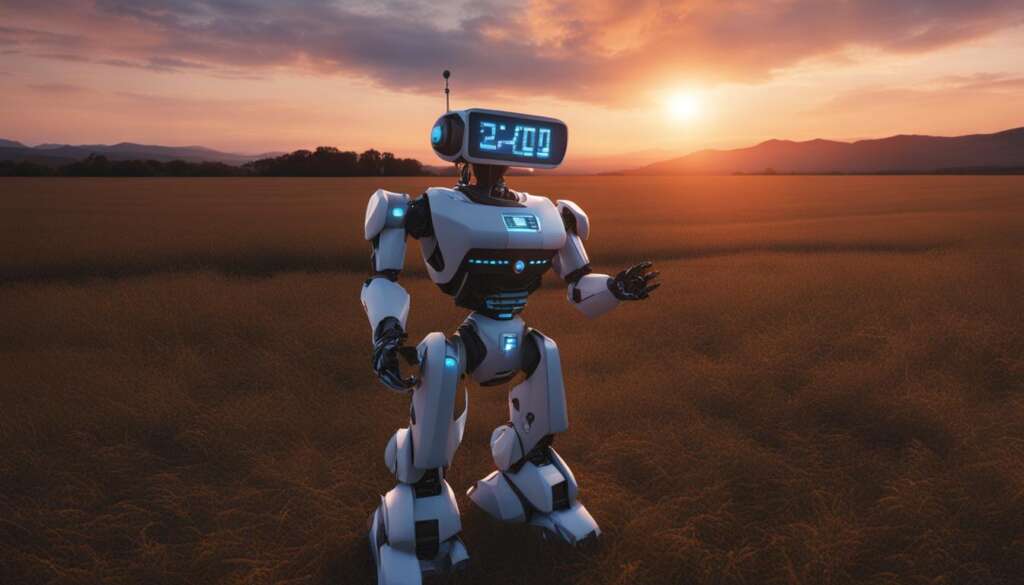Table of Contents
Get ready for the latest breakthrough in AI language models! OpenAI has announced the release date for ChatGPT 4, the highly anticipated fourth iteration in their groundbreaking GPT series. Set to launch on March 14, 2023, ChatGPT 4 is expected to bring a host of updates and advancements, revolutionizing AI-powered communication.
ChatGPT 4 builds upon the success of its predecessor, GPT-3.5, and introduces a range of powerful features and capabilities. This multimodal model incorporates pre-training on both public and licensed data, followed by reinforcement learning for fine-tuning. With a larger context window and the ability to take images as input, ChatGPT 4 sets a new standard in the field of AI language models.
OpenAI is committed to pushing the boundaries of AI technology, and ChatGPT 4 is a testament to their dedication. The release of ChatGPT 4 not only offers exciting opportunities for developers and businesses but also promises to enhance user experiences across various domains.
Stay tuned for further updates and the latest news on ChatGPT 4 as OpenAI continues to shape the future of AI communication. Whether you’re a developer, researcher, or curious enthusiast, the advancements brought by ChatGPT 4 are sure to captivate and inspire.
Features and Capabilities of GPT-4
GPT-4, the latest iteration in the GPT series, comes with a range of impressive features and capabilities that set it apart from its predecessor, GPT-3.5. Let’s explore what makes GPT-4 a powerful language model:
Larger Context Window
GPT-4 boasts a significantly larger context window compared to GPT-3.5. This expanded capacity enables the model to handle more complex instructions and provide more comprehensive and contextually accurate responses.
Multimodal Model with Image Input and Output
One of the standout advancements in GPT-4 is its multimodal capabilities. The model can now process image input and generate visual content as part of its outputs. This means that GPT-4 can not only understand and interpret text, but also work with visual data, opening up new possibilities in various domains.
System Messages for Response Specification
GPT-4 introduces the concept of “system messages” that allow users to specify the tone and task for the model’s responses. This feature enables more effective and precise interaction, ensuring that the AI chatbot responds in a manner aligned with the user’s intentions.
Improved Performance on Exams and Standardized Tests
GPT-4 has demonstrated its strengths in academics and testing scenarios. It surpasses GPT-3.5 in various subjects and has shown better performance on exams and standardized tests. This enhancement makes GPT-4 an invaluable tool for educational institutions and learners seeking accurate and reliable assistance.
High Number of Parameters
To achieve its advanced capabilities, GPT-4 is packed with over 1 trillion parameters. This significant increase in parameters contributes to the model’s ability to handle complex tasks and generate high-quality responses.
In summary
GPT-4 pushes the boundaries of AI language models with its larger context window, multimodal capabilities, system messages, improved exam performance, and a high number of parameters. These features equip GPT-4 with the tools necessary to excel in a wide range of applications, from natural language processing to content generation and beyond.
Potential Applications and Limitations of GPT-4
GPT-4, with its advanced capabilities, has a wide range of potential applications and use cases across various industries. Let’s explore some of the key areas where GPT-4 can be leveraged, as well as its limitations.
Coding Assistant
GPT-4 can serve as a valuable coding assistant, aiding programmers in identifying errors and optimizing code. Its deep understanding of programming languages and ability to analyze complex code structures make it an invaluable tool for developers seeking to streamline their coding process.
Medical Diagnosis and Analysis
In the realm of medicine, GPT-4 has demonstrated promising capabilities. It has shown excellent performance on medical exams, making it a potential aid for healthcare professionals. GPT-4 can assist in diagnosing and analyzing medical conditions, offering valuable insights and recommendations based on vast amounts of medical knowledge.
“GPT-4 has the potential to revolutionize the healthcare industry by providing valuable support and aiding in accurate medical diagnoses.” – Dr. Emily Johnson, Chief Medical Officer at Leading Medical Institution
Limitations and Challenges
While GPT-4 boasts impressive capabilities, it is not without limitations. One of the key challenges associated with GPT-4 is the generation of incorrect or inconsistent information, a phenomenon known as hallucination. This can pose risks in critical situations where accuracy is paramount.
Another limitation is the lack of transparency in GPT-4’s decision-making process. The model’s inner workings are complex and difficult to interpret, making it challenging to verify the accuracy and reliability of its responses.
| Applications | Limitations |
|---|---|
| Coding assistance | Hallucination of information |
| Medical diagnosis and analysis | Lack of transparency in decision-making |
It is important to address these limitations and continue refining GPT-4 to ensure its responsible and ethical use in various domains.
Despite these limitations, GPT-4 opens up significant possibilities for enhancing productivity, making complex tasks more manageable, and advancing research and development across industries.

In the next section of this article, we will dive into the latest updates and future developments of GPT-4, exploring the ongoing innovations in AI language models. Stay tuned for more exciting insights and advancements.
The Latest Updates and Future Developments
OpenAI is committed to continually improving and updating its GPT models, including the latest iteration, GPT-4. OpenAI’s dedication to advancement is evident in the recent announcement of GPT-4 Turbo, which offers expanded capabilities and a larger context window of 128K.
This development demonstrates OpenAI’s ongoing efforts to enhance the power and utility of the GPT models. GPT-4 Turbo aims to provide users with an even more immersive and context-rich experience, enabling the model to handle increasingly complex tasks and instructions.
Looking ahead, OpenAI is already working on the development of GPT-5, slated for release in 2024. With the introduction of GPT-5, OpenAI expects to bring further advancements to AI language models, pushing the boundaries of communication technology.
The roadmap for GPT models showcases OpenAI’s commitment to continuous innovation and progress. By consistently updating and refining their models, OpenAI aims to stay at the forefront of AI research and development, ensuring that users have access to the most advanced language models available.
GPT-4 Development Roadmap
| Milestone | Description |
|---|---|
| GPT-4 Turbo | Expanded capabilities and larger context window (128K) |
| GPT-5 Release | Expected release in 2024 with further advancements in AI language models |
The GPT-4 roadmap highlights the continuous growth and evolution of OpenAI’s language models, with GPT-5 set to build upon the successes of its predecessors.
Differentiating ChatGPT and GPT Models
Understanding the key differences between ChatGPT and GPT models is essential. While ChatGPT serves as the user-facing platform, allowing individuals to interact with the AI chatbot through a website or app, GPT-4 is the powerful language model that drives ChatGPT behind the scenes.
Developers have the ability to directly interface with GPT-4 through the OpenAI API, leveraging its advanced capabilities. By subscribing to ChatGPT Plus, users gain access to the GPT-4 model, enjoying its enhanced features and improved performance.
GPT-4 is consistently updated and refined, showcasing OpenAI’s commitment to continuous improvement. With future iterations and enhancements already in the pipeline, the GPT-4 model is set to evolve and offer even more impressive capabilities.
Conclusion
GPT-4, the latest iteration of OpenAI’s AI language models, represents a significant step forward in the field. With its advanced capabilities and multimodal features, GPT-4 has the potential to transform AI-powered tools and communication. Its larger context window allows for the handling of more complex instructions, while its ability to process and generate visual content opens up new possibilities.
However, it’s crucial to recognize the limitations of GPT-4. Like any AI model, it is not immune to generating incorrect information, which can pose challenges in certain applications. Despite this, OpenAI remains at the forefront of AI technology, continuously pushing boundaries and refining language models.
Looking ahead, OpenAI is already working on GPT-5, which promises even further advancements in AI language models. The release of GPT-4 marks a significant milestone in AI communication technology, and its ongoing development indicates a commitment to improving the power and utility of these models for various real-world applications.
FAQ
When was ChatGPT 4 released?
ChatGPT 4, also known as Generative Pre-trained Transformer 4 (GPT-4), was released on March 14, 2023.
What are the features and capabilities of GPT-4?
GPT-4 has a significantly larger context window compared to its predecessor, GPT-3.5, enabling it to handle complex instructions. It is a multimodal model that can process and generate visual content using image input and output. GPT-4 also introduces the concept of a “system message” to specify tone and task, and it has shown improved exam performance and a high number of parameters exceeding 1 trillion.
What are the potential applications and limitations of GPT-4?
GPT-4 can be used as a coding assistant, aiding programmers in finding errors and optimizing code. It also shows promise in the medical field, performing well on exams and assisting in diagnosing and analyzing medical conditions. However, it is important to note that GPT-4 may generate incorrect or inconsistent information, referred to as hallucination, and lacks transparency in decision-making, making it challenging to verify accuracy.
What are the latest updates and future developments for GPT-4?
As of now, GPT-4 Turbo has been announced, offering expanded capabilities and a larger context window of 128K. OpenAI is also working on GPT-5, scheduled for release in 2024, to bring further advancements to AI language models. The roadmap for GPT models demonstrates OpenAI’s commitment to pushing the boundaries of AI communication technology.
What is the difference between ChatGPT and GPT Models?
ChatGPT is the public interface, the website or app where users interact with the AI chatbot. GPT-4 is the large language model powering ChatGPT behind the scenes. Developers can directly interface with GPT-4 through the OpenAI API. With a ChatGPT Plus subscription, users gain access to the GPT-4 model. GPT-4 and future iterations will continue to be updated and enhanced.
What is the conclusion about ChatGPT 4?
GPT-4 represents a substantial advancement in AI language models, offering improved capabilities and a wider range of applications. With its multimodal capabilities and large context window, GPT-4 has the potential to revolutionize AI-powered tools and communication. However, it is crucial to acknowledge the limitations, such as the potential for generating incorrect information. OpenAI is continuously working on future iterations, like GPT-5, to further enhance language models, reflecting their commitment to advancing AI technology.













